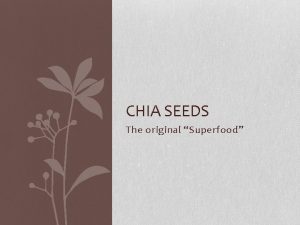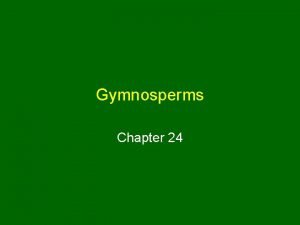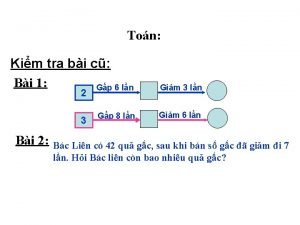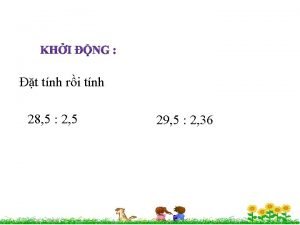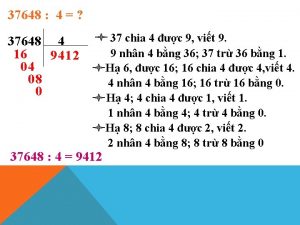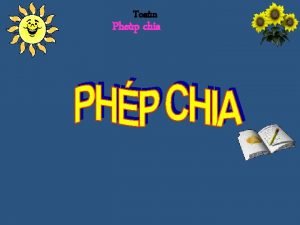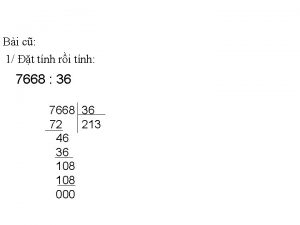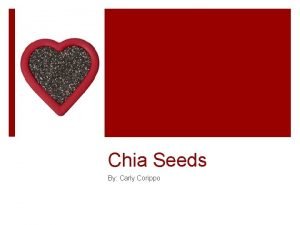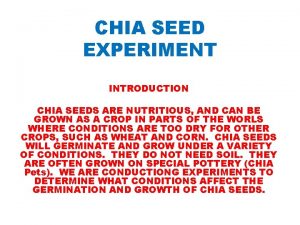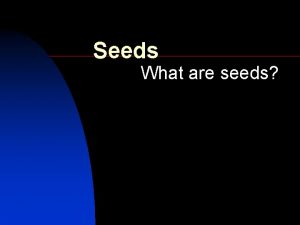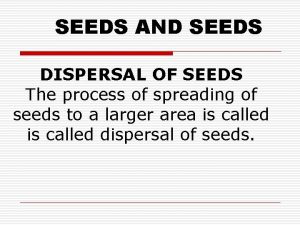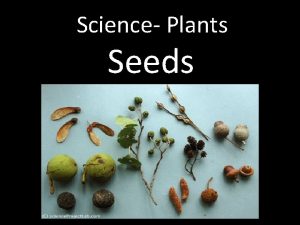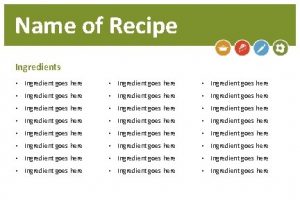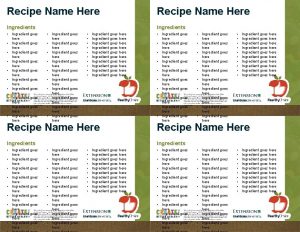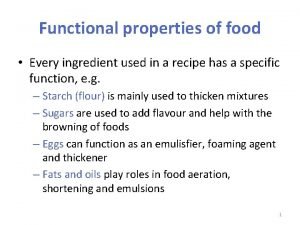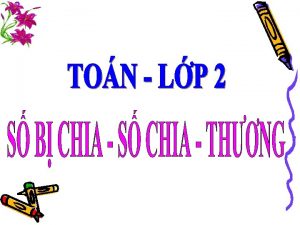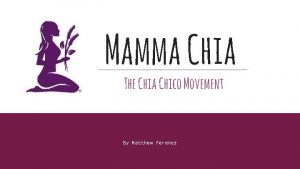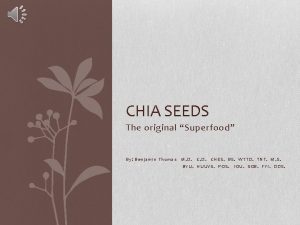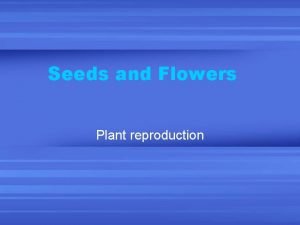Chia Seeds as a Functional Food Ingredient in


















- Slides: 18

Chia Seeds as a Functional Food Ingredient in Baked Goods Mc. Kenna Murphy, Karlene van der Jagt, Vickie Be. Lue

Introduction The tiny black or white Chia seed derives from a flowering plant, which is part of the mint family called Salvia hispanica. 1, 2 The seeds are an excellent source of omega-3 fatty acid and have been associated with the improvement of cardiovascular disease, including the lowering of cholesterol, triglycerides, and blood pressure. This power packed seed also contains protein and minerals; iron, calcium, magnesium, and zinc. Chia seed use is versatile and can be eaten whole or milled. 1, 2 Functional Food is defined as whole foods along with fortified, enriched, or enhanced foods that have potentially beneficial effects on health when consumed as part of a varied diet. 3 1. Academy of nutrition and Dietetics Website. http: //www. eatright. org/resource/food/vitamins-and-supplements/nutrient-rich-foods/what-are-chia-seeds. Accessed February 6, 2016. . 2. National Institute of Health. National Cancer Institute. Division of Cancer Prevention Web site. http: //prevention. cancer. gov/news-and-events/news/nutrition-frontiers-winter. 3. Crowe KM, Francis. Position of the Academy of Nutrition and Dietetics: functional foods. Academy of Nutrition and Dietetics. 2013; 113: 1096 -1103.

Introduction Chia seed is an ancient oilseed that was used by the Mayas and Aztec tribes in Mexico. 4 The Mayas and Aztecs used chia seed as part of their diet, but they also used it for religious reasons; it was used as an offering to the gods. The use of chia seed as consumption by humans started around 3500 BC, and became a staple crop in central Mexico around 1500 and 900 BC. Chia seeds was used in foods, medicines, and paintings. In addition, chia seed was one of the main crops of pre-Columbian societies. 4 The pre-Columbian people not only consumed chia seeds as part of a dish, but they also made a beverage out of it, known as “chia fresca. ” 4. Muñoz L, Cobos A, Diaz O, Aguilera J. Chia Seed (Salvia hispanica ): An Ancient Grain and a New Functional Food Reviews International. October 2, 2013; 29(4): 394 -408.

Introduction The chia seed is of particular interest, as it offers the highest amount of omega-3 fatty acids of any vegetable source. it offers an alternative source of omega-3 fatty acids to that of fish such as salmon, which offers the highest amount of omega-3 fatty acids as a food source. 5 Having an alternative is important as fish are not always consumed for religious, ethical, and availability reasons. A strong correlation exists between chia seed consumption and a reduction in cardiovascular disease (CVD). 5 It is a nutrient-dense food containing: alpha-linolenic acid, dietary fiber, calcium, protein, magnesium, antioxidants, and iron. 5 Chia seeds act as an ideal functional food, an additive that offers additional health benefits beyond basic nutrition, in breads and other baked goods. 6 Traditionally, breads and baked goods have high amounts of fat and are a staple in the human diet. Utilizing chia seeds in baked goods could lead to low fat products with high amounts of dietary fiber and omega-3 fatty acids. 5. Cooper R. Review article: Re-discovering ancient wheat varieties as functional foods. Journal Of Traditional And Complementary Medicine. July 1, 2015; 5: 138 -143. Accessed February 7, 2016. 6. Coelho M, Salas-Mellado M. Effects of substituting chia (Salvia hispanica L. ) flour or seeds for wheat flour on the quality of the bread. LWT - Food Science And Technology. March 1, 2015; 60 (Part 1): 729 -736. Accessed February 7, 2016.

Research Question What characteristics and qualities of chia seeds make them an ideal functional food ingredient in baked goods?

Study #1 Evaluation of Whole Chia (Salvia hispanica L. ) Flour and Hydrogenated Vegetable Fat in Pound Cake. ● Purpose: To determine the effect of incorporating different amounts of whole chia flour (WCF) and hydrogenated vegetable fat (HVF) on the technological quality of cakes. ● Materials: Wheat flour, whole chia flour (milling chia seeds), hydrogenated vegetable fat, sugar, baking powder, and whole milk powder. ● Methods: ○ Protein, carbohydrate, lipid, ash, total fiber, soluble and insoluble fiber contents of the wheat and chia flours were determined. ○ Basic cake formulation: flour mixture (wheat flour and whole chia flour) (100 g), sugar (100 g), egg (40 g), baking powder (3. 3 g) and whole milk powder (11. 2 g); ○ Cake preparation: sugar, eggs and fat were mixed for 2 min at high speed; the wheat flour, whole chia flour, water and whole milk powder were then added to the cream and mixed for 1 min at high speed. Finally the baking powder was added to the batter and mixed for 30 s at low speed. The batter was then transferred to aluminium pans previously greased with butter, and placed in an oven at 160 ± 2 °C for 30 min. ○ The amounts of whole chia flour and hydrogenated vegetable fat were established according to a 22 central composite rotational design (CCRD) with a total of 11 test. The amount of WCF added ranged between 0 and 30 g/100 g flour mixture and the amount of HVF between 12 and 20 g/100 g flour mixture 7. Luna Pizarro P, Almeida E, Sammán N, Chang Y. Evaluation of Whole Chia (Salvia hispanica L. ) Flour and Hydrogenated Vegetable Fat in Pound Cake. LWT - Food Science And Technology. November 1, 2013; 54: 73 -79.

● Methods: Response surface methodology was used to analyse the technological characteristics of the cakes with WCF and HVF as the independent variables, and the specific volume, crumb colour parameters, moisture content and firmness after 1, 4 and 7 days of storage as the dependent variables. ● Results: 7. Luna Pizarro P, Almeida E, Sammán N, Chang Y. Evaluation of Whole Chia (Salvia hispanica L. ) Flour and Hydrogenated Vegetable Fat in Pound Cake. LWT - Food Science And Technology. November 1, 2013; 54: 73 -79.

Results: ● The specific volume of the cakes ranged from 2. 15 to 2. 67 m. L/g. The cake with the lowest specific volume had a concentration of HVF (12 g/100 g flour mixture) and an intermediate concentration of WCF (15 g/100 g flour mixture). The highest value of specific volume had no added WCF (0 g/100 g flour) and an intermediate HVF concentration (16 g/100 g flour mixture). ● WCF made the crumb colour darker by producing a less saturated colour, and it appeared to be more red in color compared to no added WCF. ● The addition of WCF and HVF had no significant effect on the moisture content after 1, 4 and 7 days of storage ● The addition of intermediate concentrations of WCF (close to 15 g/100 g flour mixture) and the highest concentrations of HVF (>16 g/100 g flour mixture) resulted in less firm cakes. However, the addition of intermediate concentrations of WCF (close to 15 g/100 g flour mixture) and the lowest concentrations of HVF (close to 12 g/100 g flour mixture) resulted in very firm cakes. Conclusion: ● It is possible to incorporate WCF into pound cake formulations and obtain a product with good technological qualities. The presence of hydrogenated vegetable fat (HVF) helps to minimize the adverse effects of WCF on the specific volume and firmness of the cakes. The best technological results were obtained for cakes produced with up to 15 g WCF/100 g flour mixture and from 16 to 20 g HVF/100 g flour mixture. 7. Luna Pizarro P, Almeida E, Sammán N, Chang Y. Evaluation of Whole Chia (Salvia hispanica L. ) Flour and Hydrogenated Vegetable Fat in Pound Cake. LWT - Food Science And Technology. November 1, 2013; 54: 73 -79.

Study #2 Effect of Pre-hydration of Chia (Salvia hispanica L. ), Seeds and Flour on the Quality of Wheat Flour Breads. Purpose: To explore the effect of added chia seeds or flour (with and without pre-hydration) on the sensory and technological quality of wheat flour bread. Materials: Wheat flour (11. 25 g/100 g protein, 14. 54 g/100 g moisture), chia seed (3. 78 g/100 g moisture, 23. 90 g/100 g protein, 32. 86 g/100 g lipid), chia flour came from milling chia seed for 10 seconds using a super junior “s” grinder, Dry yeast, Saf-Instant, and salt. Bread Samples Evaluated: Samples used were wheat flour (control), wheat flour with chia flour (5 g, 10 g and 15 g of chia flour/100 g wheat flour) and wheat flour with previously hydrated chia flour (5 g, 10 g and 15 g of hydrated chia flour/100 g wheat flour). Methods: Dough Properties: Dough. Lab, rheofermentometer, and alveograph tests were used to study waterabsorption, mixing behaviour, and fermentation time of the dough. Bread Making: Bread samples were made the same despite variable changes. Chia flour was added at 10 g/100 g wheat flour. 8. Steffolani E, Martinez M, León A, Gómez M. Effect of Pre-hydration of Chia (Salvia hispanica L. ), Seeds and Flour on the Quality of Wheat Flour Breads. LWT - Food Science And Technology. May 1, 2015; 61: 401 -406. Accessed February 7, 2016.

Evaluation of Bread Quality: A laser sensor measured bread volume. Crumb Texture was assessed on 30 mm thick bread slices at 18 hours after baking. Weight loss was measured as the difference between the weight of the dough before and after baking. Consumer Testing: ● Participants: 66 volunteers were chosen. They aged from 18 to 55, 28 men and 38 women, had varying socioeconomic backgrounds and came from the Agricultural Engineering College of Palencia in Spain. ● Nine-point hedonic scale: acceptance of their appearance (half-piece slices), flavour, taste, flavour persistency, texture, and overall acceptability was evaluated using a 2 cm slice of bread. A 4 digit number was used to randomize breads. Evaluations were conducted one day after bread baking. Results: Dough Properties: ● All chia flour types had a decrease in extensibility (L) and an increase in tenacity (P) compared to the control. ● All doughs made with chia absorbed more water. Except for doughs made by 5 g/100 g and 10 g/100 g of chia flour without hydration. ● Chia flour incorporation led to an increase in fermentation time and lower maximum heights than the control. ● Pre-hydrated chia flour decreased development time and more mucilage was formed. ● Dough stability was weakened with the addition of all types of chia flour. 8. Steffolani E, Martinez M, León A, Gómez M. Effect of Pre-hydration of Chia (Salvia hispanica L. ), Seeds and Flour on the Quality of Wheat Flour Breads. LWT - Food Science And Technology. May 1, 2015; 61: 401 -406. Accessed February 7, 2016.

Bread Quality: ● Chia flour reduced the volume of bread samples, but pre-hydration had less effect. ● A negative correlation exists (r = − 0. 96; p < 0. 001) between the specific volume of the bread and the firmness of the crumb. ● Springiness of the bread crumb was reduced by all chia flour incorporation. Consumer Testing: ● Control breads and those with added chia seeds did not have a significant difference in evaluated parameters. ● Physical properties: texture, colour, taste and flavour are different, but assessment by consumers did not show significant differences. ● Breads constructed from chia flour had lower scores than control bread for texture, persistence of flavour and appearance. ● Taste, smell and overall evaluation had no significant differences between control and pre-hydrated flour breads, but chia flour without pre-hydration led to lower scores. Conclusion: Chia flour concentrations of 10 g/100 g can be added to wheat bread with no affect on consumer acceptability; especially, pre-hydrated chia flour or seed. 8. Steffolani E, Martinez M, León A, Gómez M. Effect of Pre-hydration of Chia (Salvia hispanica L. ), Seeds and Flour on the Quality of Wheat Flour Breads. LWT - Food Science And Technology. May 1, 2015; 61: 401 -406. Accessed February 7, 2016.

Consumer Testing Results: Effect of 10 g/100 g chia addition on consumer's acceptance. Values with different letters in the same parameter are significantly different (p < 0. 05). Visual appearance Odor Texture Flavour persistence Overall acceptability Control 7. 30 b 6. 71 b 6. 80 c 6. 44 b 6. 30 c 6. 74 b Chia Flour 5. 97 a 5. 68 a 5. 86 a 5. 47 a 5. 36 a 5. 67 a Hydrated Chia Flour 6. 17 a 6. 35 b 6. 30 a b 6. 02 b 5. 80 ab 6. 29 b Chia Seed 6. 98 b 6. 55 b 6. 35 bc 6. 44 b 6. 08 bc 6. 47 b Hydrated Chia Seed 6. 98 b 6. 68 b 6. 58 bc 6. 45 b 6. 20 bc 6. 65 b 8. Steffolani E, Martinez M, León A, Gómez M. Effect of Pre-hydration of Chia (Salvia hispanica L. ), Seeds and Flour on the Quality of Wheat Flour Breads. LWT - Food Science And Technology. May 1, 2015; 61: 401 -406. Accessed February 7, 2016.

Study #3 A Dietary Pattern Including Nopal, Chia Seed, Soy Protein and Oat, Reduces Serum Triglycerides and Glucose Intolerance in Patients with Metabolic Syndrome ● Purpose: To evaluate the effects of a dietary pattern (DP): soy protein, nopal, chia seed, and oat) on the biochemical variables of Met. S, the AUC for glucose and insulin, glucose intolerance (GI), the relationship of the presence of certain polymorphisms related to Met. S, and the response to the DP. ● Materials: ○ A single-center, randomized, placebo-controlled, double-blind, parallel-arm study. ○ 97 Mexican mestizos, aged 20 -60 y, BMI > 25 and < 39. 9 kg/m 2, who satisfied 3 positive criteria for Met. S. Participation was in two stages. ○ Participants received 15 different eating plans (50%-60% carbohydrate, 15% protein, 25%35% fat, < 7% saturated fat based on total energy, cholesterol < 200 mg/d and 20 - 30 g/d fiber. 9. Guevara-Cruz M, Tovar AR, Aguilar-Salinas CA, et al. A Dietary Pattern Including Nopal, Chia Seed, Soy Protein, and Oats Reduces Serum Triglycerides and Glucose Intolerance in Patients with Metabolic Syndrome. J Nutr. 2012; 142: 64 -69.

● ● Methods ○ Stage One - participants consumed a reduced energy diet; low saturated fat and low cholesterol diet for two weeks. ○ Stage Two - participants were randomly assigned to consume either the dietary plan or a placebo in addition to the reduced energy diet for two months. ○ Monitoring period - four visits; first visit - medical history and a 2 -hr. blood glucose and serum insulin levels were recorded for 120 min after the administration of 75 g of oral glucose. Second and third visits - a 24 -hr. Dietary recall was conducted, a physical activity questionnaire was completed, and anthropometry and serum biochemical variables were measured. Final visit - 2 -hr. Test from visit one was repeated. Results ○ 67 participants completed the study. ○ Energy intake was reduced by 500 kcal in both groups but the macro- and micronutrient intakes did not differ between the groups. ○ Blood pressure, body weight, BMI, and waist circumference decreased but there was no change in the percentages of the lean or fat mass in either group. ○ Participants in the DP group had a significant decrease in serum triglycerides. 9. Guevara-Cruz M, Tovar AR, Aguilar-Salinas CA, et al. A Dietary Pattern Including Nopal, Chia Seed, Soy Protein, and Oats Reduces Serum Triglycerides and Glucose Intolerance in Patients with Metabolic Syndrome. J Nutr. 2012; 142: 64 -69.

● The percentage of participants with glucose intolerance in the DP group at baseline was 40. 6% and significantly reduced after 2 mo. to 18. 8%. ○ ● The presence of (n-3) fatty acids and antioxidants in the chia seed could promote a reduction in the inflammatory response. Conclusion ○ Dietary intervention using chia seed can be easily achieved in a population and can be translated to individuals at risk for diabetes and CVD who prefer to include local, beneficial foods in their diet as a means of improving their health. ○ Limitation of this study is that the sample size was designed to study the effect of DP on clinical and biochemical variables of Met. S and not to study the association between DP and the presence of polymorphisms and Met. S biochemical abnormalities. ○ This study could aid in the development of new studies with larger Met. S cohorts. 9. Guevara-Cruz M, Tovar AR, Aguilar-Salinas CA, et al. A Dietary Pattern Including Nopal, Chia Seed, Soy Protein, and Oats Reduces Serum Triglycerides and Glucose Intolerance in Patients with Metabolic Syndrome. J Nutr. 2012; 142: 64 -69.

Application to Dietetic Practice Due to the health benefits chia seeds provide, dietitians can inform patients about this product. Chia seeds are an excellent source of fiber, vitamins, minerals, and antioxidants. Dietitians can inform patients how chia seeds can be added to foods in order to increase its nutritional value. Many baked products do not necessarily have the proper nutritional value; thus, adding chia to it can enhance the product’s nutritional value without significantly affecting the volume, texture, moisture, or taste. Incorporating the use of chia seeds in baking may assist in the lowering of blood glucose intolerance and serum triglycerides. This is a viable option for patients that want to eat baked goods to not feel deprived or severely restricted.

Application to Dietetic Practice Further research needs to be done by research dietitians to answer current questions that practicing dietitians can use to encourage clients to have a healthful lifestyle. more research needs to be done to determine if pre-hydration of chia seeds or lack of prehydration of chia seeds is more or less beneficial in the preparation of baked goods; especially bread. Currently pre-hydration has been found to increase firmness in bread, but this has been found to be undesirable to consumers. However, pre-hydration encourages a longer shelf life and a stable gluten network in dough. 8 Another avenue of research would be to explore the impact of the nutritional quality of chia seeds undergoing the milling and/or hydration pretreatment process. 8 One more would be studying whether the incorporation of chia seeds into baked goods decreases the overall nutritional value of the seeds. Overall, more research needs to be done to improve the quality of chia seed usage in baked goods. 8. Steffolani E, Martinez M, León A, Gómez M. Effect of Pre-hydration of Chia (Salvia hispanica L. ), Seeds and Flour on the Quality of Wheat Flour Breads. LWT - Food Science And Technology. May 1, 2015; 61: 401 -406. Accessed February 7, 2016.

References 1. Academy of Nutrition and Dietetics. Web site. http: //www. eatright. org/resource/food/vitamins-and-supplements/nutrient-rich-foods/what-are-chia-seeds. Accessed February 6, 2016. 2. National Institute of Health. National Cancer Institute. Division of Cancer Prevention Web site. http: //prevention. cancer. gov/news-andevents/news/nutrition-frontiers-winter 3. Crowe KM, Francis. Position of the Academy of Nutrition and Dietetics: functional foods. Academy of Nutrition and Dietetics. 2013; 113: 1096 -1103. 4. Muñoz L, Cobos A, Diaz O, Aguilera J. Chia Seed (Salvia hispanica ): An Ancient Grain and a New Functional Food Reviews International. October 2, 2013; 29(4): 394 -408. 5. Cooper R. Review article: Re-discovering ancient wheat varieties as functional foods. Journal Of Traditional And Complementary Medicine. July 1, 2015; 5: 138 -143. Accessed February 7, 2016. 6. Coelho M, Salas-Mellado M. Effects of substituting chia (Salvia hispanica L. ) flour or seeds for wheat flour on the quality of the bread. LWT - Food Science And Technology. March 1, 2015; 60 (Part 1): 729 -736. Accessed February 7, 2016. 7. Luna Pizarro P, Almeida E, Sammán N, Chang Y. Evaluation of Whole Chia (Salvia hispanica L. ) Flour and Hydrogenated Vegetable Fat in Pound Cake. LWT - Food Science And Technology. November 1, 2013; 54: 73 -79. 8. Steffolani E, Martinez M, León A, Gómez M. Effect of Pre-hydration of Chia (Salvia hispanica L. ), Seeds and Flour on the Quality of Wheat Flour Breads. LWT - Food Science And Technology. May 1, 2015; 61: 401 -406. Accessed February 7, 2016. 9. Guevara-Cruz M, Tovar AR, Aguilar-Salinas CA, et al. A dietary Pattern Including Nopal, Chia seed, Soy Protein, and Oats Reduces Serum Triglycerides and Glucose Intolerance in Patients with Metabolic Syndrome. J Nutr. 2012; 142: 64 -69.
 Chia seeds
Chia seeds Ecological importance of gymnosperms
Ecological importance of gymnosperms Apple tree monocot or dicot
Apple tree monocot or dicot Band and loop space maintainer indications
Band and loop space maintainer indications Functional and non functional plasma enzymes
Functional and non functional plasma enzymes Functional and non functional plasma enzymes
Functional and non functional plasma enzymes Functional and non functional
Functional and non functional Muốn tìm số chia
Muốn tìm số chia 28,5:2,5
28,5:2,5 Bảng chia 7
Bảng chia 7 Workforce cerner
Workforce cerner Social media trend analysis
Social media trend analysis 37648 chia 4
37648 chia 4 26345 chia 752
26345 chia 752 Corrycom chia
Corrycom chia Thử lại phép chia
Thử lại phép chia Chia hui chang
Chia hui chang Sai ở đâu 12345 67
Sai ở đâu 12345 67 Bảng nhân 3
Bảng nhân 3
